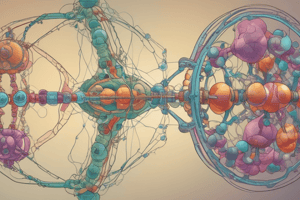Podcast
Questions and Answers
What is the primary role of pyrimidine analogs in cancer therapy?
What is the primary role of pyrimidine analogs in cancer therapy?
- They specifically target hypoxanthine-guanine phosphoribosyltransferase.
- They enhance the immune response against cancer cells.
- They act as competitive inhibitors against all nucleotide pathways.
- They disrupt DNA synthesis and kill dividing cells. (correct)
Which of the following best describes the type of inhibition caused by antimetabolite drugs?
Which of the following best describes the type of inhibition caused by antimetabolite drugs?
- They completely stop enzyme activity by binding irreversibly.
- They change the conformation of enzymes to enhance activity.
- They compete with normal substrates for enzyme binding. (correct)
- They increase the activity of other pathways to compensate.
What physiological feature is mentioned regarding the enzymes involved in pyrimidine metabolism?
What physiological feature is mentioned regarding the enzymes involved in pyrimidine metabolism?
- They are only active during cell division.
- They show allosteric regulation in the presence of uracil.
- They have high Km values indicating low binding affinity. (correct)
- They have low affinity and thus are very effective.
Which type of therapy specifically targets molecular properties unique to cancer cells?
Which type of therapy specifically targets molecular properties unique to cancer cells?
Which statement correctly describes the role of HGPRTase in chemotherapy?
Which statement correctly describes the role of HGPRTase in chemotherapy?
What is a primary mechanism by which tumor cells develop resistance to chemotherapy?
What is a primary mechanism by which tumor cells develop resistance to chemotherapy?
Which type of DNA repair pathway is primarily involved in repairing damage caused by alkylating agents?
Which type of DNA repair pathway is primarily involved in repairing damage caused by alkylating agents?
Which type of ionizing radiation is most likely to cause double-strand DNA breaks?
Which type of ionizing radiation is most likely to cause double-strand DNA breaks?
What is NOT a characteristic of common chemoresistance mechanisms?
What is NOT a characteristic of common chemoresistance mechanisms?
Which mechanism primarily addresses errors that occur during DNA replication?
Which mechanism primarily addresses errors that occur during DNA replication?
What type of damage is classified as a result of exposure to UV light?
What type of damage is classified as a result of exposure to UV light?
In what context do reactive oxygen species (ROS) primarily induce DNA damage?
In what context do reactive oxygen species (ROS) primarily induce DNA damage?
Which type of DNA damage involves both strands being affected?
Which type of DNA damage involves both strands being affected?
What is the primary action of 5-fluorouracil (5-FU) and methotrexate in cancer treatment?
What is the primary action of 5-fluorouracil (5-FU) and methotrexate in cancer treatment?
Which nucleophilic site in DNA is considered the most reactive?
Which nucleophilic site in DNA is considered the most reactive?
What type of bond is formed as a result of interstrand crosslinking in DNA?
What type of bond is formed as a result of interstrand crosslinking in DNA?
Why are DNA damaging agents more effective in targeting cancer cells compared to normal cells?
Why are DNA damaging agents more effective in targeting cancer cells compared to normal cells?
What role does orotidylate phosphoribosyl transferase (OPRT) play in the metabolism of 5-FU?
What role does orotidylate phosphoribosyl transferase (OPRT) play in the metabolism of 5-FU?
Which of the following describes the function of alkylating chemotherapeutics?
Which of the following describes the function of alkylating chemotherapeutics?
What is the outcome of FUMP being converted into RNA?
What is the outcome of FUMP being converted into RNA?
Which mechanism is primarily utilized by chemotherapeutic drugs to induce cancer cell death?
Which mechanism is primarily utilized by chemotherapeutic drugs to induce cancer cell death?
Study Notes
Enzyme Activity and Salvage Pathway
- Salvage pathways for pyrimidine nucleotide synthesis involve enzymes with high Km, indicating lower affinity for substrates.
- Orotic acid (or uracil) reacts with PRPP to form pyrimidine nucleotides.
- Pyrimidine nucleotides can convert to pyrimidine nucleosides via a reaction with ribose-1-phosphate.
- High Km suggests limited physiological relevance, particularly when administering pharmacological doses of pyrimidine analogs.
Cancer Therapy Modalities
- Treatment options include surgery, radiation therapy, immunotherapy, and chemotherapy.
- Chemotherapy can be cytotoxic, targeting dividing cells, or targeted, focusing on properties unique to cancer cells.
- Competitive inhibitors such as hypoxanthine-guanine phosphoribosyltransferase (HGPRTase) play a role in chemotherapy.
Chemotherapy Overview
- Chemotherapy is defined as the use of drugs to treat diseases, primarily focusing on DNA-damaging and antimetabolite drugs targeting nucleotide synthesis.
- 5-Fluorouracil (5-FU) and methotrexate inhibit synthesis of dTMP through covalent binding to enzymes.
5-FU Metabolism
- 5-FU is metabolized into FUMP and 5F-dUMP, utilizing orotidylate phosphoribosyl transferase (OPRT) in the process.
Cancer Treatment Strategies
- Multi-drug approaches are often employed to maximize therapeutic effects.
- Apoptosis, or programmed cell death, is crucial in cancer therapy effectiveness.
Chemotherapeutic Drugs: Mechanisms
- DNA damaging agents exploit nucleophilic centers in DNA to initiate reactions that impair function.
- The N7 position of guanine is identified as the most nucleophilic site in DNA bases.
Alkylating Agents and Crosslinking
- Alkylating chemotherapy agents create interstrand crosslinks between complementary DNA strands, inhibiting replication and transcription.
Therapeutic Index of DNA-Damaging Agents
- Approved DNA-damaging agents are more effective against cancer cells compared to normal cells due to a favorable therapeutic index.
Chemoresistance Mechanisms
- Cancer cells can develop resistance via:
- Decreased drug uptake
- Increased export of drugs
- Enhanced detoxification mechanisms
- Reduced pro-drug activation
- Increased DNA repair capabilities
DNA Repair Pathways
- Different DNA repair mechanisms target specific damaging agents, including:
- Direct repair and base excision repair for alkylating agents
- Nucleotide excision repair for UV light
- Mismatch repair for replication errors
- Single and double-strand break repair for ionizing radiation
Ionizing Radiation and DNA Damage
- Ionizing radiation causes DNA damage, leading to single and double-strand breaks, and the formation of reactive oxygen species (ROS).
- High Linear Energy Transfer (LET) from sources like α particles results in double-strand breaks, while low LET from β particles and x-rays primarily leads to single-strand breaks and base damage.
Studying That Suits You
Use AI to generate personalized quizzes and flashcards to suit your learning preferences.
Related Documents
Description
Explore the pivotal role of enzymes in pyrimidine metabolism as highlighted in the 2016 Dental Biochemistry context. This quiz delves into the physiological relevance of high Km enzymes and their implications in cancer therapy, including the incorporation of pyrimidine analogs in DNA. Test your knowledge on these biochemical pathways and their pharmacological significance.



